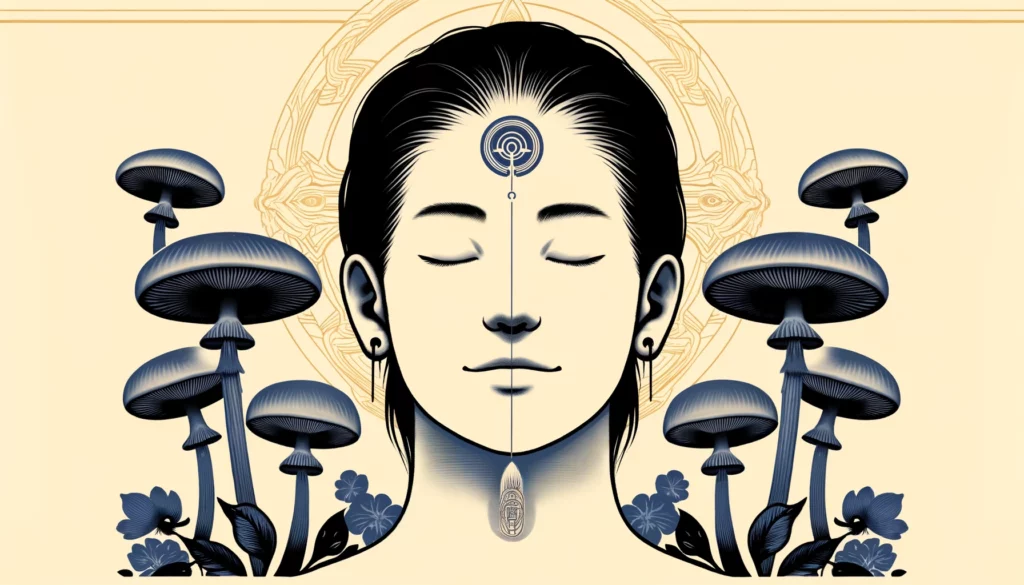
From a Western perspective, Kundalini Yoga can be seen as a biological concept expressed through poetic metaphor. The system makes a significant effort to unify the seemingly separate aspects of body and mind. Though it is a complex doctrine, in simple terms, it guides practitioners through the mastery of six stages, known as chakras, which coordinate body and mind. The sixth and most revered stage is called the sahasrara.
This sixth chakra, the sahasrara, is located at the center of the forehead and is represented by an eye — often referred to as the third eye. When this eye is opened, it reveals a completely different dimension of reality to the yoga practitioner.
For centuries, cultures around the world have revered mushrooms for their mystical properties, believing they hold the key to unlocking the mysteries of the mind and opening the “third eye.”
This ancient reverence for mystical insight finds a parallel in the scientific journey to understand the pineal gland, an organ long associated with the third eye.
In the 4th century BCE, the Greek physician Herophilus first identified the gland. However, it remained relatively obscure until the 17th century when René Descartes described it as the “seat of the soul,” proposing it as the point of interaction between mind and body.

Significant advancements occurred in the 19th century when German zoologist Franz Leydig described the gland’s structure in 1872, noting its presence in European lizards. In 1886, British zoologist Walter Baldwin Spencer discovered the pineal gland’s association with a light-sensitive structure in some reptiles, known as the parietal eye. This discovery suggested that the pineal gland might have once functioned as a photoreceptor organ.
In the 20th century, Aaron B. Lerner and his team at Yale University made a groundbreaking discovery in 1958 by isolating melatonin, a hormone produced by the pineal gland. Melatonin plays a crucial role in regulating sleep-wake cycles and seasonal biological rhythms, highlighting the gland’s importance in the body’s circadian rhythms. This discovery opened new avenues in chronobiology and further clarified the pineal gland’s functions.

Psilocybin mushrooms possess an extraordinary power, harboring psilocybin, a potent psychedelic compound that, upon ingestion, transforms into psilocin within the body. This chemical marvel deeply affects serotonin receptors in the brain, triggering profound alterations in perception and thought processes. Users often describe their journeys as transcendent, immersing them in vibrant waves of color, intricate geometric patterns, and a deep sense of interconnectedness with the universe. These experiences are frequently depicted as “seeing with the third eye,” a metaphor that echoes the pineal gland’s ancient association with spiritual awakening and insight. The visions and epiphanies that arise are not mere hallucinations but deeply personal revelations that dismantle the barriers between the self and the cosmos, offering a glimpse into the boundless possibilities of human consciousness. Through this transformative lens, psilocybin mushrooms become more than just a psychoactive substance; they are keys to the hidden realms of the mind, gateways to a deeper understanding of our spiritual essence and the mysteries of existence.
The activation of the pineal gland through psilocybin mushrooms is a theory that captivates the imagination with its profound implications. This idea stems from the structural similarity between serotonin, a key neurotransmitter, and psychedelic compounds like psilocybin. When ingested, psilocybin converts to psilocin, which may influence the pineal gland, potentially altering melatonin production and overall gland activity. Such activation is believed to open the gates of perception, allowing individuals to transcend ordinary consciousness and access deeper, more spiritual realms of awareness.
Adding to this mystique is the speculation that the pineal gland might release DMT, a potent psychedelic, during heightened states of consciousness or under the influence of psilocybin. Though not conclusively proven, this hypothesis suggests that the gland serves as a bridge between the physical and spiritual worlds, unlocking experiences that feel timeless, boundless, and infused with profound meaning. These altered states could provide a window into the infinite, revealing truths about existence that are normally obscured by the mundane filters of everyday perception.
In an age where we are constantly bombarded with information, many feel confined by the boundaries of conventional thinking and seek deeper, more meaningful experiences. Mushrooms, with their profound ability to alter consciousness, offer a gateway to these deeper realms of understanding.
The idea that profound truths can be uncovered through altered states of consciousness is not new. Historically, various cultures have believed that in the midst of what appears to be madness, there lies a core of divine knowledge. This belief has roots in ancient traditions, from the Thracian worship of Dionysius to the philosophical musings of Pythagoras and the elaborate dialogues of Plato. These traditions have long held that substances like mushrooms can open the third eye, revealing the hidden laws of the universe and providing insights into the true nature of reality.
For more readings you can find an in-depth analysis of this is Your Mind on Mushroom: Mushroom and the Third Eye

I am Woman King an I need a lot of help my road it feels blocked
What an intriguing article! The website’s seamless navigation made it
even more enjoyable to explore.